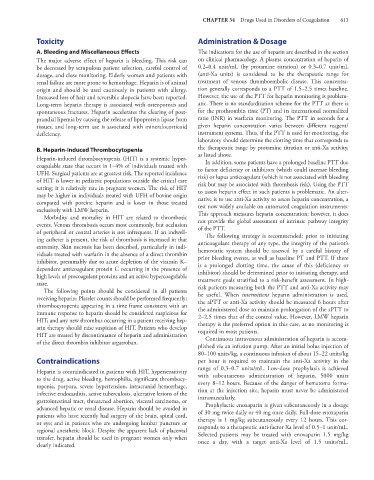Page 627 - Basic _ Clinical Pharmacology ( PDFDrive )
P. 627
CHAPTER 34 Drugs Used in Disorders of Coagulation 613
Toxicity Administration & Dosage
A. Bleeding and Miscellaneous Effects The indications for the use of heparin are described in the section
The major adverse effect of heparin is bleeding. This risk can on clinical pharmacology. A plasma concentration of heparin of
be decreased by scrupulous patient selection, careful control of 0.2–0.4 unit/mL (by protamine titration) or 0.3–0.7 unit/mL
dosage, and close monitoring. Elderly women and patients with (anti-Xa units) is considered to be the therapeutic range for
renal failure are more prone to hemorrhage. Heparin is of animal treatment of venous thromboembolic disease. This concentra-
origin and should be used cautiously in patients with allergy. tion generally corresponds to a PTT of 1.5–2.5 times baseline.
Increased loss of hair and reversible alopecia have been reported. However, the use of the PTT for heparin monitoring is problem-
Long-term heparin therapy is associated with osteoporosis and atic. There is no standardization scheme for the PTT as there is
spontaneous fractures. Heparin accelerates the clearing of post- for the prothrombin time (PT) and its international normalized
prandial lipemia by causing the release of lipoprotein lipase from ratio (INR) in warfarin monitoring. The PTT in seconds for a
tissues, and long-term use is associated with mineralocorticoid given heparin concentration varies between different reagent/
deficiency. instrument systems. Thus, if the PTT is used for monitoring, the
laboratory should determine the clotting time that corresponds to
B. Heparin-Induced Thrombocytopenia the therapeutic range by protamine titration or anti-Xa activity,
Heparin-induced thrombocytopenia (HIT) is a systemic hyper- as listed above.
In addition, some patients have a prolonged baseline PTT due
coagulable state that occurs in 1–4% of individuals treated with to factor deficiency or inhibitors (which could increase bleeding
UFH. Surgical patients are at greatest risk. The reported incidence risk) or lupus anticoagulant (which is not associated with bleeding
of HIT is lower in pediatric populations outside the critical care risk but may be associated with thrombosis risk). Using the PTT
setting; it is relatively rare in pregnant women. The risk of HIT to assess heparin effect in such patients is problematic. An alter-
may be higher in individuals treated with UFH of bovine origin native is to use anti-Xa activity to assess heparin concentration, a
compared with porcine heparin and is lower in those treated test now widely available on automated coagulation instruments.
exclusively with LMW heparin. This approach measures heparin concentration; however, it does
Morbidity and mortality in HIT are related to thrombotic
events. Venous thrombosis occurs most commonly, but occlusion not provide the global assessment of intrinsic pathway integrity
of the PTT.
of peripheral or central arteries is not infrequent. If an indwell- The following strategy is recommended: prior to initiating
ing catheter is present, the risk of thrombosis is increased in that anticoagulant therapy of any type, the integrity of the patient’s
extremity. Skin necrosis has been described, particularly in indi- hemostatic system should be assessed by a careful history of
viduals treated with warfarin in the absence of a direct thrombin prior bleeding events, as well as baseline PT and PTT. If there
inhibitor, presumably due to acute depletion of the vitamin K– is a prolonged clotting time, the cause of this (deficiency or
dependent anticoagulant protein C occurring in the presence of inhibitor) should be determined prior to initiating therapy, and
high levels of procoagulant proteins and an active hypercoagulable treatment goals stratified to a risk-benefit assessment. In high-
state. risk patients measuring both the PTT and anti-Xa activity may
The following points should be considered in all patients
receiving heparin: Platelet counts should be performed frequently; be useful. When intermittent heparin administration is used,
the aPTT or anti-Xa activity should be measured 6 hours after
thrombocytopenia appearing in a time frame consistent with an the administered dose to maintain prolongation of the aPTT to
immune response to heparin should be considered suspicious for 2–2.5 times that of the control value. However, LMW heparin
HIT; and any new thrombus occurring in a patient receiving hep- therapy is the preferred option in this case, as no monitoring is
arin therapy should raise suspicion of HIT. Patients who develop required in most patients.
HIT are treated by discontinuance of heparin and administration Continuous intravenous administration of heparin is accom-
of the direct thrombin inhibitor argatroban.
plished via an infusion pump. After an initial bolus injection of
80–100 units/kg, a continuous infusion of about 15–22 units/kg
Contraindications per hour is required to maintain the anti-Xa activity in the
range of 0.3–0.7 units/mL. Low-dose prophylaxis is achieved
Heparin is contraindicated in patients with HIT, hypersensitivity
to the drug, active bleeding, hemophilia, significant thrombocy- with subcutaneous administration of heparin, 5000 units
topenia, purpura, severe hypertension, intracranial hemorrhage, every 8–12 hours. Because of the danger of hematoma forma-
infective endocarditis, active tuberculosis, ulcerative lesions of the tion at the injection site, heparin must never be administered
gastrointestinal tract, threatened abortion, visceral carcinoma, or intramuscularly.
advanced hepatic or renal disease. Heparin should be avoided in Prophylactic enoxaparin is given subcutaneously in a dosage
patients who have recently had surgery of the brain, spinal cord, of 30 mg twice daily or 40 mg once daily. Full-dose enoxaparin
or eye; and in patients who are undergoing lumbar puncture or therapy is 1 mg/kg subcutaneously every 12 hours. This cor-
regional anesthetic block. Despite the apparent lack of placental responds to a therapeutic anti-factor Xa level of 0.5–1 unit/mL.
transfer, heparin should be used in pregnant women only when Selected patients may be treated with enoxaparin 1.5 mg/kg
clearly indicated. once a day, with a target anti-Xa level of 1.5 units/mL.

